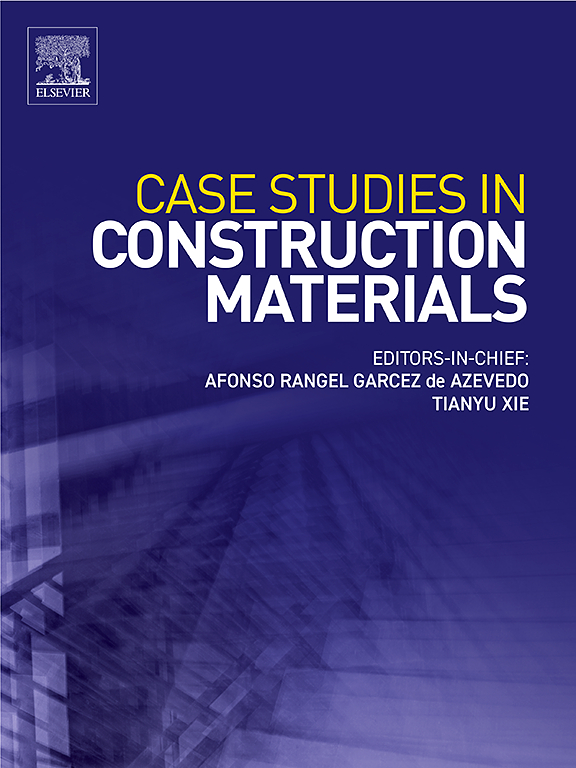二氧化碳陶粒泡沫混凝土的发展:力学性能、微观结构和环境效益
IF 6.6
2区 工程技术
Q1 CONSTRUCTION & BUILDING TECHNOLOGY
引用次数: 0
摘要
随着全球碳中和目标的推进,建筑行业作为主要的资源消耗和碳排放行业,面临着越来越严峻的环境压力。建筑材料的生产不仅消耗大量的能源,而且产生大量的二氧化碳。这种情况要求开发新型低碳材料和碳封存技术。本研究提出了一种新型的CO 2发泡陶粒泡沫混凝土(CCFC),并通过实验方法系统研究了其力学性能、多尺度孔隙结构演化和环境效益。CO₂发泡显著细化了CCFC的孔隙结构,提高了CCFC的抗压强度和吸水能力,同时降低了其导热系数。从宏观到微观的多尺度分析表明,CaCO₃是由碳酸化作用产生的,填充了孔隙,优化了孔隙分布。生命周期评估(LCA)表明,与传统陶粒泡沫混凝土(CFC)相比,每立方米CCFC可封存约25 千克二氧化碳,将全球变暖潜能值(GWP)降低12% %。这些研究结果表明,CCFC可以作为建筑围护结构中传统保温材料的可持续替代品,显著降低建筑项目中的碳足迹。通过将二氧化碳封存整合到轻质混凝土生产中,该技术符合全球碳中和目标,并为减少城市基础设施中的隐含碳提供了可扩展的解决方案。此外,CCFC改善的机械和热性能支持其在节能建筑中的应用,有助于结构安全和长期节能。研究结果为推广低碳建筑实践提供了实践指导。与其他新兴的低碳混凝土(如地聚合物或矿化体系)相比,CCFC展示了环境性能、结构适用性和工业可扩展性的平衡整合。本文章由计算机程序翻译,如有差异,请以英文原文为准。
Development of CO₂-ceramsite foam concrete: Mechanical properties, microstructure and environmental benefits
With the advancement of the global carbon neutrality goal, the construction industry, as a major resource consumption and carbon emission sector, is facing increasingly severe environmental pressures. Building material production not only consumes substantial energy but also generates significant CO₂ emissions. This context necessitates the development of novel low-carbon materials and carbon sequestration technologies. This study proposes a novel CO₂-foamed ceramsite foam concrete (CCFC), and systematically investigates its mechanical properties, multi-scale pore structure evolution, and environmental benefits through experimental approaches. CO₂ foaming significantly refined the pore structure of CCFC, enhancing its compressive strength and water absorption capacity while reducing thermal conductivity. Multi-scale analyses from macro to micro levels revealed that CaCO₃ generated through carbonation filled pores and optimized pore distribution. Life cycle assessment (LCA) demonstrated that each cubic meter of CCFC sequesters approximately 25 kg CO₂, reducing global warming potential (GWP) by 12 % compared to conventional ceramsite foam concrete (CFC). These findings indicate that CCFC can serve as a sustainable alternative to traditional insulation materials in building envelopes, significantly lowering carbon footprints in construction projects. By integrating CO₂ sequestration into lightweight concrete production, this technology aligns with global carbon neutrality goals and offers a scalable solution for reducing embodied carbon in urban infrastructure. Furthermore, the improved mechanical and thermal performance of CCFC supports its application in energy-efficient buildings, contributing to both structural safety and long-term energy savings. The findings offer practical guidance for scaling low-carbon construction practices. Compared to other emerging low-carbon concretes such as geopolymer or mineralized systems, CCFC demonstrates a balanced integration of environmental performance, structural applicability, and industrial scalability.
求助全文
通过发布文献求助,成功后即可免费获取论文全文。
去求助
来源期刊

Case Studies in Construction Materials
Multiple-
CiteScore
7.60
自引率
19.40%
发文量
842
审稿时长
63 days
期刊介绍:
Case Studies in Construction Materials provides a forum for the rapid publication of short, structured Case Studies on construction materials. In addition, the journal also publishes related Short Communications, Full length research article and Comprehensive review papers (by invitation).
The journal will provide an essential compendium of case studies for practicing engineers, designers, researchers and other practitioners who are interested in all aspects construction materials. The journal will publish new and novel case studies, but will also provide a forum for the publication of high quality descriptions of classic construction material problems and solutions.
 求助内容:
求助内容: 应助结果提醒方式:
应助结果提醒方式:


